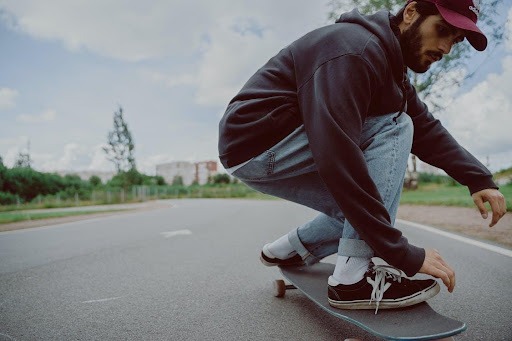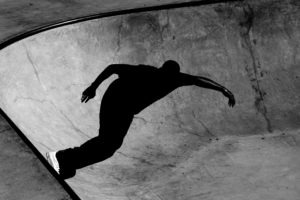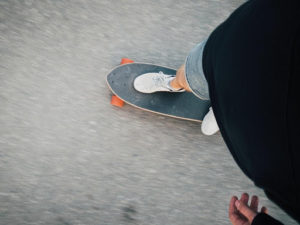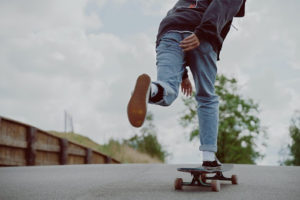Your skate session is only as good as it is safe. Practicing general skateboarding safety during every ride should be a priority for every skater. Injuries have the ability to keep you off your board for months at a time, or more.
There are many components to skateboard safety, and one of the most fundamental aspects is learning how to stop swiftly and confidently. Skateboards can quickly reach high speeds, even on flat surfaces, and not knowing how to slow down in time can be a serious safety concern.
Though it may feel a little less exciting than tricks, learning how to stop on a skateboard is a crucial skill you need to master early on, as you’ll use it every time you step out to skate. Not only will it keep you from wrecking yourself, but it will also prevent you from crashing into others and falling into jumps or drops that might be too much for your current skill level.
If you’re struggling to learn how to properly slow down and stop on your skateboard or are looking to brush up on your technique, keep reading below for some of the most common stopping methods.
What You’ll Need
- Skateboard. Make sure you skateboard is high-quality. You shouldn’t be skating on a cheap toy skateboard, but you don’t need to spend an arm and a leg on your first board either. Pre-built complete skateboards are great options for beginners.
- Helmet. Protective gear like a proper fitting helmet should be worn at all times, but now that you’re actively riding your board and working on your balance, having the right safety gear becomes even more crucial. Your helmet should have full contact around your whole head, with no spaces between the padding and your head.
- Pads. Often touted as optional, additional gear like padding and guards are an especially good idea when practicing how to stop. A few bumps and falls are part of the learning curve (and an inevitable part of skating itself), so it’s best to be prepared.
- Skate shoes. While you don’t need to drop a fortune on the latest skate sneakers, it’s important to wear the right kind of shoes. Opt for shoes with a low profile and thinner soles to maintain maximum board feel. If you plan to learn tricks later on, it’s a good idea to invest in quality pair of skate shoes. Many types of skate shoes are designed with skating conditions in mind, with features such as enhanced heel support and shock absorption, which can come in handy for certain stopping methods.
How to Stop on a Skateboard
Foot Brake Method
One of the safest methods of stopping on a skateboard, and the one most recommended for beginners, is the foot brake method. Also called the drag method, this form of stopping works best on flat surfaces when you’re not traveling at high speeds.
- Slightly lower your stance and turn your front foot towards the nose of the board.
- Drop your back foot off of the board, aiming to place it flat on the ground.
- Use your foot to apply light pressure against the ground.
- Gradually apply more pressure until you slow and are able to come to a complete stop on your skateboard.
Heel Brake Method
Once you feel comfortable with the foot brake method, you can try your hand at the heel braking or heel dragging method. The heel brake also works best for level surfaces.
- Place your back foot towards the tail, behind the truck bolts.
- Shift your weight onto that back foot, while letting up on the front.
- Press your back foot down so the nose and front wheels of the board lift up off the ground.
- Drop the heel of your back foot and drag it on the ground. Your heels should ultimately drag you to rest. This is why it’s important to wear skate shoes with a durable heel and enhanced shock absorption.
Some skaters use the tail dragging method, which is very similar to heel braking. The only difference is the tail of the board hits the ground and drags it to rest instead of the heel. While this isn’t an incorrect way to stop, we generally caution against it as it can lead to a ground-down razor tail.
Powerslide
Once you start to feel more comfortable on your board, you can start to venture into other stopping methods, such as the powerslide. The powerslide works well when traveling downhill and at higher speeds. Although it’s an advanced technique and tough to learn, it’s worth the effort if you plan to skate downhill often. If you are venturing into downhill rides and lots of tricks, we recommend starting out with smaller hills.
- Position your front foot near the front truck and your back foot near the back trucks.
- Bend your knees and lower your stance.
- Shift most of your weight towards the front foot and slide your back wheels 90 degrees horizontally underneath you.
- Slightly lean your upper body back and let the board slide across the ground.
- Once the board begins to lose speed, center your body back over the board.
- Come out of the powerslide by reversing the 90-degree rotation with your back foot.
Jumping Off
While it’s not the most stylish of methods, we want to make clear that jumping off of your skateboard or “bailing” is always an option. It’s not always the most effective way to stop, but it’s often your first instinct, and sometimes, the only option.
Always remember to practice safety first when you’re learning how to stop on a skateboard!








